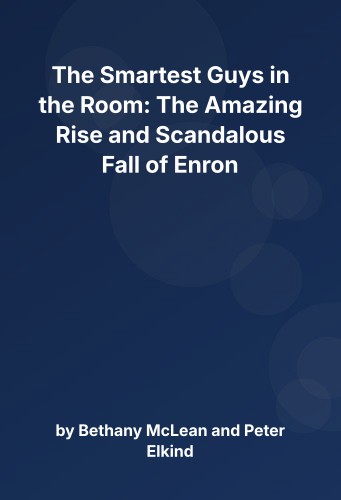Summary
The Smartest Guys in the Room by Bethany McLean and Peter Elkind is an investigative masterpiece that dissects the rise and catastrophic fall of Enron Corporation, once considered a paragon of innovation and financial brilliance. Through meticulous reporting, the authors expose how a culture of arrogance, financial engineering, and ethical compromise culminated in one of the most notorious corporate scandals in American history.
More than just an account of fraud, the book is a cautionary tale about unchecked ambition, regulatory failure, and the dangers of hubris among corporate elites who believed themselves immune to consequences.
The Rise of Enron
Enron began in the mid-1980s as a pipeline company resulting from the merger of Houston Natural Gas and InterNorth. Under CEO Ken Lay, it pivoted toward energy trading, positioning itself as a pioneer of deregulated energy markets.
By the late 1990s, Enron was hailed as one of the most innovative companies in America. It expanded into broadband, weather derivatives, and global markets, promising to revolutionize industries. On paper, Enron’s earnings soared, and its executives became Wall Street darlings.
But beneath the surface, the company was masking debt, inflating profits, and constructing a house of cards.
The Culture of Arrogance
Enron attracted top MBAs, analysts, and dealmakers, cultivating a culture of intellectual superiority. Executives like Jeff Skilling and Andrew Fastow embodied this mindset, believing that financial innovation and aggressive risk-taking justified bypassing conventional norms.
Skilling’s “rank and yank” system—where the lowest-performing employees were fired annually—fostered ruthless internal competition and discouraged dissent. The company’s mantra was to appear profitable at any cost, even if reality told a different story.
The Role of Jeff Skilling
Skilling, who became COO and later CEO, championed the transformation of Enron from an asset-heavy company to a “gas bank”—a trader of energy commodities. His embrace of mark-to-market accounting allowed Enron to book projected future profits immediately, even for deals that might never materialize.
This encouraged managers to structure deals for accounting optics rather than business value. As long as they looked profitable on paper, they were approved and rewarded.
Skilling’s philosophical disdain for regulation and traditional business models blinded him to the ethical implications of Enron’s practices.
Andrew Fastow and the Web of Deception
CFO Andrew Fastow constructed a complex network of special purpose entities (SPEs) to hide Enron’s mounting debt and inflate earnings. These off-balance-sheet entities—like LJM1 and LJM2—allowed Enron to transfer assets and liabilities, masking the true financial condition of the company.
In many cases, Fastow’s SPEs were financed with guarantees from Enron stock, creating a feedback loop that made the company’s fortunes dangerously dependent on its share price. Fastow personally profited millions from these vehicles, all while claiming they were in Enron’s best interest.
The Analysts and Media
Wall Street analysts largely failed to question Enron’s opaque financials. Enron’s complexity, coupled with its charisma and reputation, insulated it from scrutiny. Few analysts could even explain how the company made money.
The media too, enamored by Enron’s image as a Silicon Valley-style innovator in Houston, was slow to challenge the narrative.
It was Bethany McLean’s own 2001 article in Fortune, asking “Is Enron Overpriced?”, that became the first public crack in the company’s façade.
Board and Auditor Complicity
Enron’s board of directors, despite having full visibility into Fastow’s dual roles, approved his SPEs. Their deference to management and desire to preserve Enron’s stock value compromised their fiduciary responsibility.
Arthur Andersen, Enron’s auditor, rubber-stamped questionable accounting practices. The firm made millions in consulting fees from Enron, compromising its independence. Ultimately, Andersen shredded documents during the investigation, leading to its downfall.
The book details how the gatekeepers—auditors, lawyers, and regulators—either looked the other way or were complicit.
The Collapse
In 2001, as the stock market shifted and investor skepticism grew, the contradictions in Enron’s financial structure became unsustainable. Analysts began questioning its earnings and off-balance-sheet entities.
When Fastow’s SPEs unraveled and it became clear that Enron had been hiding billions in debt, confidence collapsed. In December 2001, Enron filed for bankruptcy—the largest in U.S. history at the time.
Employees lost their jobs and pensions. Shareholders lost billions. And public trust in corporate America was severely shaken.
The Aftermath
Skilling, Lay, and Fastow faced legal prosecution. Fastow cooperated with prosecutors and served prison time. Skilling and Lay were convicted, though Lay died before sentencing.
The Enron scandal contributed directly to the passage of the Sarbanes-Oxley Act in 2002, which imposed stricter financial reporting and accountability standards on public companies.
Arthur Andersen was convicted of obstruction of justice (later overturned), but its reputation was irreparably damaged.
Themes and Lessons
- Complexity as Obfuscation: Enron weaponized complexity to avoid scrutiny. This remains a risk in modern finance and technology.
- Ethics Over Intelligence: Being smart is no substitute for being ethical. Arrogance blinds leaders to their responsibilities.
- Systemic Failure: The scandal wasn’t the work of a few bad actors. It revealed structural weaknesses in corporate governance, auditing, and oversight.
- Short-Term Thinking: A focus on quarterly results encouraged deception over sustainability.
Why This Book Matters
The Smartest Guys in the Room is not just a chronicle of fraud—it’s a deeply researched, character-driven narrative about ambition, deception, and systemic failure. It’s required reading for anyone in business, finance, or governance.
The book offers a sobering reminder of how innovation, without accountability, can veer into criminality—and how those who seem the smartest may also be the most dangerous.
TL;DR
Enron’s collapse was the result of unchecked ambition, fraudulent accounting, and systemic complicity. The Smartest Guys in the Room is a masterclass in investigative journalism and a timeless warning against the perils of arrogance, opacity, and ethical decay in corporate leadership.

